What is SLA Management? Understand the Benefit of SLA Monitoring Tools
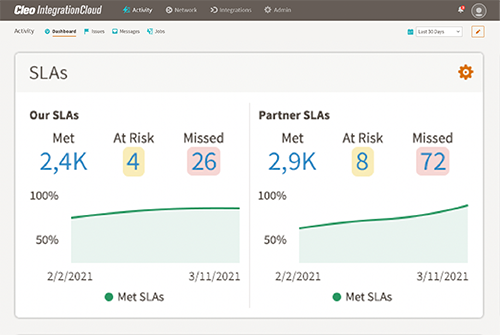
The clarity in communication helps in every relationship prosper, be it personal or business.
With proper Service Level Agreement (SLA) definition, and consistent SLA management using SLA monitoring tools, you can better serve your customers, protect your business, and achieve financial predictability and higher profits.
Because when expectations are clearly defined, shared upfront, understood, and lived up to, a partnership will thrive. If a promise is not kept, however, relationships can suffer and become costly.
For manufacturers, logistics & transportation companies, wholesale distributors, and retailers, it's important to define SLAs and perform regular SLA monitoring because business-critical relationships are heavily predicated on these Service Level Agreements.
What Is an SLA?
SLAs are essentially written contracts that codify the mutual expectations in a business partner relationship, define metrics by which service is measured, and spell out penalties for under-performance.
Generally speaking, the reason a Service Level Agreement or SLA is important is because of what's in it - essentially the agreed-upon terms that set the parameters of a relationship. SLAs are unique to every relationship and can be quite different from one industry to another.
In manufacturing, for instance, an SLA defines the level of service expected by a customer from its supplier.
In cloud software, an SLA expresses the legal relationship between a company and a software vendor.
In logistics & transportation, it is an agreement between a logistics service supplier and their client.
It's important to realize too that SLA documents are also "living" documents that call for regular tracking and compliance, so it is important to know how to monitor Service Level Agreements and have the right tools to live up to them.
Regardless of industry, a common SLA will consist of:
- Objectives, Services, responsibilities
- Measurement - Agreed-upon metrics for accuracy
- Response times
- Obligations
- Penalties
The other commonality is that SLAs need to be actively managed.
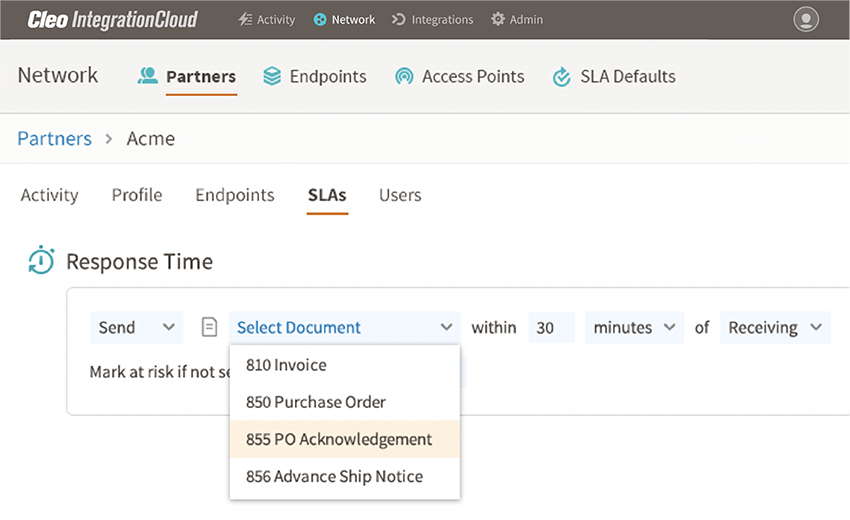
What is SLA Management?
So what exactly is SLA Management? Well, as we said SLAs are "living" documents, which means not only can the agreements change but the parties to the agreement need to live up to it as projects are executed under the terms of the agreement.
And that means both the agreement itself and the degree to which it is lived up to must both be managed.
Management in the first case means regularly revisiting the terms of the agreement.
Change is the only constant in business and commerce, so they say, and ensuring the agreement is clear and has no oversights or flaws is important.
The second case has to do with the ongoing process of ensuring all provided services stipulated in the underlying contract are in alignment.
For instance, was a manufacturer's delivery to its retail customer made on time and in full (OTIF)?
Walmart first introduced OTIF as a key performance metric (KPI) back in 2017, and much of the retail industry has embraced it since that time.
For the most part, SLAs are established between companies and their suppliers and thus are very important for companies that choose to outsource certain services, like shipping for example.
Good SLA management helps ensure the terms of an SLA are met.
Poor SLA management can mean unwelcome penalties or chargebacks, and very unhappy business partners, which strains a valuable relationship.
What makes for good SLAs? Things like mutual understanding of each parties' point of view. Not having too many SLAs in the mix and making relationships over-complicated. Or only including KPIs or performance metrics that are clear and achievable, not vague or difficult to measure.
What makes for bad SLAs? It could be assuming both parties share the same understanding, overlooking security requirements of each companies' IT systems, or one party focusing more on potential penalties and fees rather than delivering services excellence.
Simply put, sound SLA management helps you automate, track, and measure the digital processes that a key relationship depends on. That might mean ensuring billing processes work as expected and that the specifications of the system are clear, or it may be agreeing on how support tickets are prioritized.
Time is also a key factor, and measures around response time or resolution time can also be valuable inclusions.
Achieving SLA compliance is good for all parties. As we like to say, when it comes to meeting SLAs it's better to be reliable than … just liable. And clarity in the agreements and how they are managed can make all the difference.
Because the main thing to remember about good versus bad SLAs is that the bad ones can cost your company unexpected amounts of money.
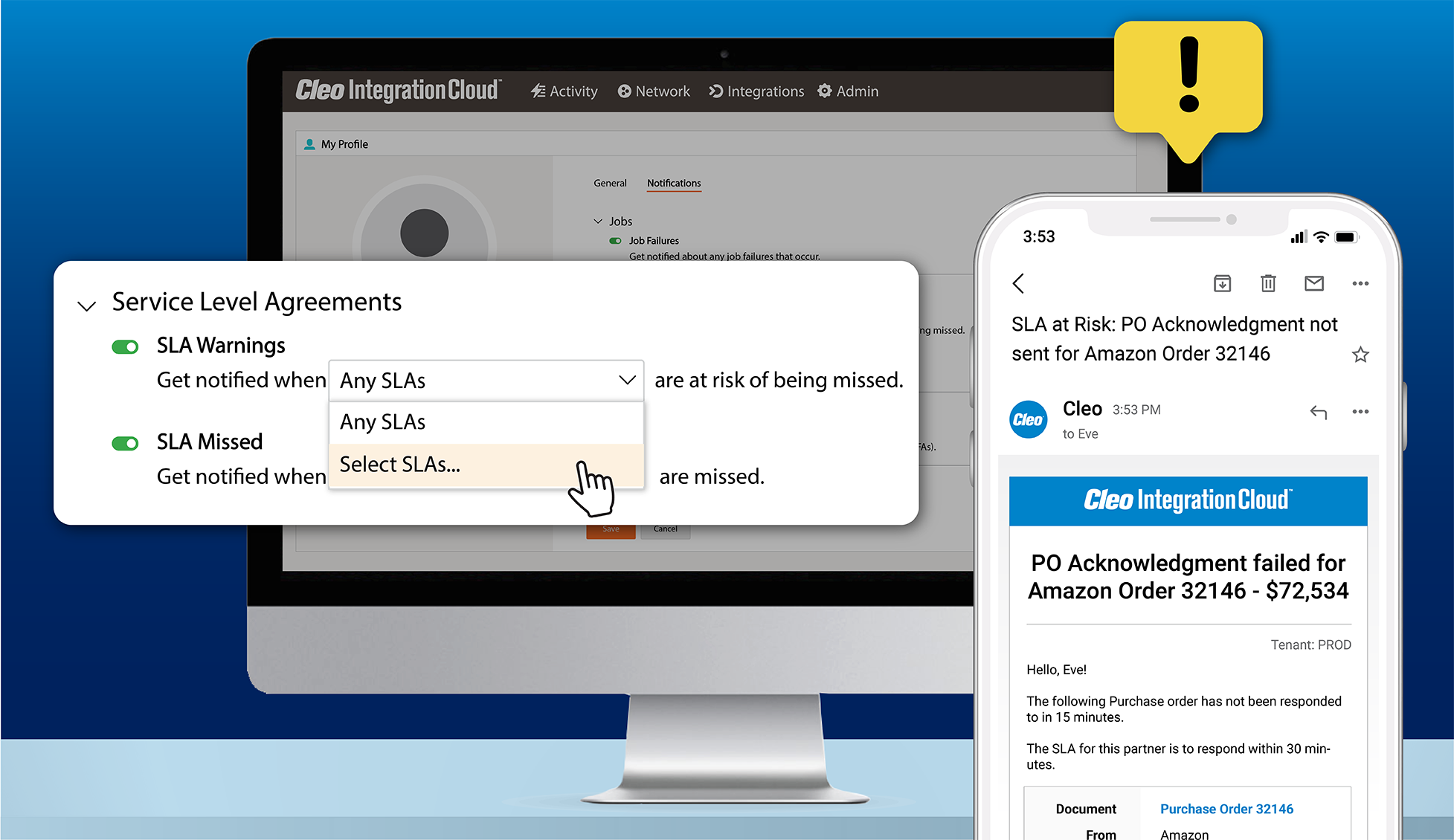
Cut SLA Violation Costs with G2’s #1 Rated Solution
Rethink how you manage your supply chain-related business commitments with forward-looking intelligence on KPIs, customer expectations, and SLAs.
Why is a Service Level Agreement (SLA) Important?
Let's remember that the purpose of an SLA is to enable companies to transact business transparently and efficiently.
To better understand why a Service Level Agreement is important, and some of the potential complexities involved, let's take a mainstream example involving EDI or Electronic Data Interchange compliance.
EDI compliance refers to a business's capacity to accurately send and receive EDI transactions according to the order data requirements of its EDI trading partners.
Many companies insist that their trading partners communicate using EDI software, including retail giants like Walmart, Target, Costco, and Amazon.
These companies have rules around all the specific EDI documents they rely on to conduct business.
Walmart for example lays out 4 EDI compliance requirements for all partners:
- The ability to exchange the basic EDI document set
- The timeline for EDI data testing
- Connection requirements
- Functional acknowledgment expectations
Examples of some of the basic EDI documents required by Walmart are:
- 810 Invoice
- 821 Claim
- 816 Address Listing
- 820 Remittance
- 850 Purchase Order
- 864 Text Message [for invoice errors]
- 997 Acknowledgment
Beyond this, honoring specifically defined time metrics is also important. For example, Walmart dictates that the period in which a vendor must prove that they are capable of transmitting all of the basic documents can take no longer than 6 weeks.
Otherwise, that vendor may be eliminated from Walmart's ecosystem for non-compliance.
Another time measure involves the timely sending of EDI 997s, functional acknowledgment documents, which Walmart stipulates vendors must provide within 24 hours of when Walmart's Purchase Order was received.
There's more.
To conduct trade with Walmart, a vendor has to maintain a consistent AS2 connection.
Any disruption to this connection, such as a drop in connectivity even for a few minutes, can negatively impact a company's trading relationship with the retail giant.
As you can see, SLAs that cover the details of these requirements provide valuable benefits for both customers and service providers.
The purpose of SLAs then is to:
- Manage customer expectations
- Define the circumstances in which partners can't hold them liable for service outages or issues related to performance
- Establish performance targets and benchmarks
- Have clear guidelines, maintain peace of mind
The price of failure to meet SLAs can be steep. Here's an example from another retail giant, Amazon.
In this instance, as the penalty for missing this SLA Amazon is charging the vendor 1% of what Amazon paid for the overall order if the Purchase Order acknowledgment is not received by Amazon within 12 hours.
That amounts to a 10% hit to the profit margin on the order!
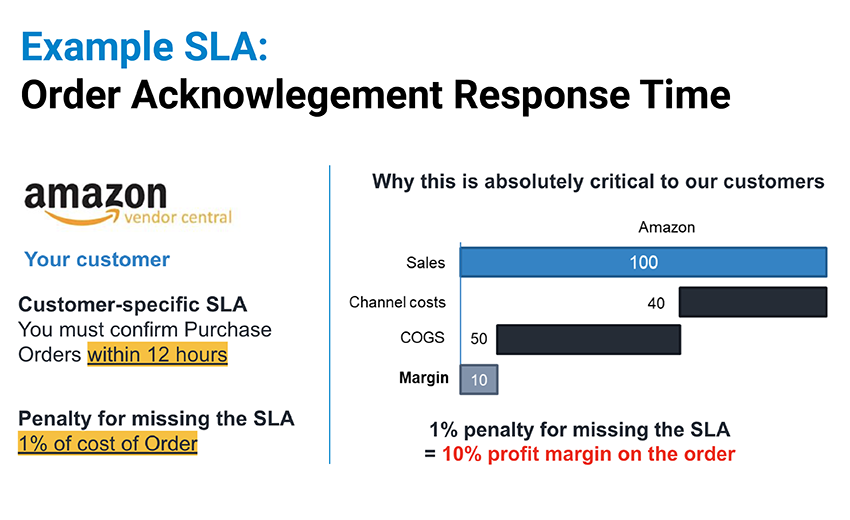
How to Monitor Service Level Agreements
Thus far we've discussed what Service Level Agreements are, why they are important and provided some examples of how a few companies go about implementing SLAs and the potential SLA penalties a vendor can incur for non-compliance.
Now let's get into why monitoring Service Level Agreements is critical and how to do it.
Good SLA management is accomplished via a logical process that is often reciprocal.
Think of it like a dance, where every move invites a sequential response. In the world of SLAs, there is a triggering event, such as sending a Purchase Order, that starts a clock ticking until the Order Acknowledgement is received.
Then there's another triggering event, such as the Order is received and the clock ticks until the item is shipped.
Likewise, once the shipping notice is issued, then an Invoice may be triggered, and in time, when the shipment starts making its way to the destination, a load tender is issued, and a load tender acknowledgment comes when the final delivery has been received.
All this is very logical, but it can also become exceedingly complex at scale. When companies the size of Walmart or Amazon are in the mix, just imagine the hundreds of thousands of processes like this going on daily all around the world.
Realistically it is very hard for companies to keep up with everything that's happening, and that's why you need to take control of your SLAs.
You want to stay in the know at all times - don't wait to find out from your customer that there's a potential problem.
How do you do that? With top-notch SLA performance management using industry-leading, modern SLA monitoring tools, such as a tool that can help you identify and act on at-risk SLAs before they are missed. Or one that enables you to define & configure SLAs in minutes.
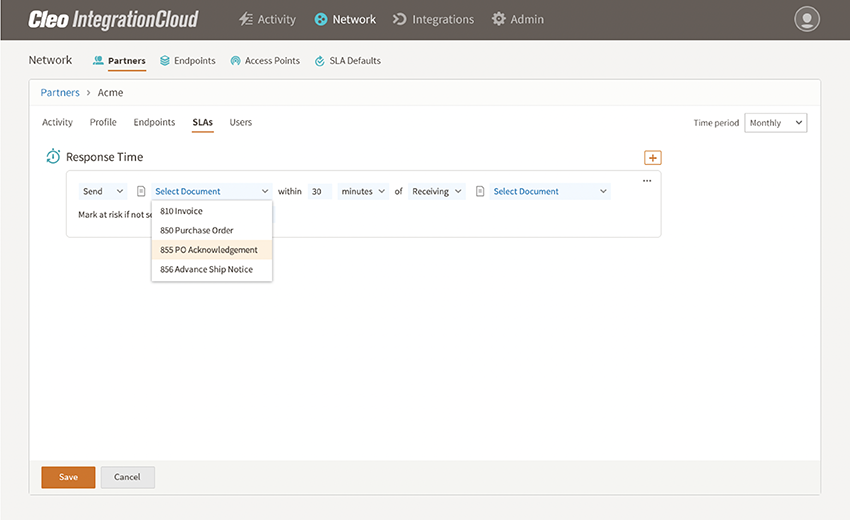
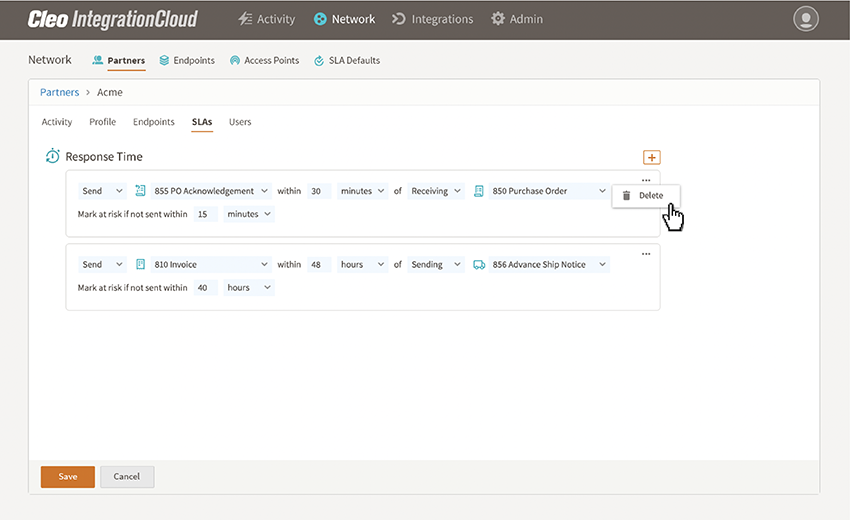
Meet Your SLAs.
EDI compliance and Service Level Agreement violations can cost supply chain companies millions of dollars in fines and chargebacks annually.
With today's modern integration platform capabilities, however, you can take control over your SLAs, and define, measure, report, and act immediately on time-sensitive SLA notifications.
CIC Cockpit with RADAR„¢ delivers everything you need.
Built on top of CIC Cockpit, the integration industry's most comprehensive real-time operational dashboard, RADAR empowers supply chain-driven businesses to mitigate compliance risk by defining, measuring, reporting, and acting immediately on time-sensitive SLA notifications.
SLAs can be configured in minutes by business, operational, or technical users - instantly creating dashboards and charts to monitor these Key Performance Indicators (KPIs) in real-time.
Additionally, users can quickly create thresholds to receive alerts and notifications before SLA violations occur. Each user gets to define alerts that are relevant or valuable to their specific role, making every real-time notification both timely and actionable.
CIC RADAR includes critical components and tools to allow organizations to rethink how they set up, monitor, measure, and optimize business performance:
SLA Monitoring and Management:
- Intuitively configure globally accessible SLA definitions
- Filter and report on operations by SLA status
SLA Notifications:
- Get an immediate notification for at-risk or missed SLAs
- Opt-in to SLA alerts to get insights needed in your role
SLA Dashboards:
- View SLA metrics by customer and partner
- Prioritize and act on impacted transactions to protect revenue, relationships, and reputation.
See Cleo Integration Cloud (CIC) Cockpit with RADAR for Yourself
Watch a short demo video, take a self-guided product tour, or request a meeting with a Cleo Solution Architect to learn how an early warning system covering your SLAs can help you redefine how you monitor, measure, and optimize business compliance performance.
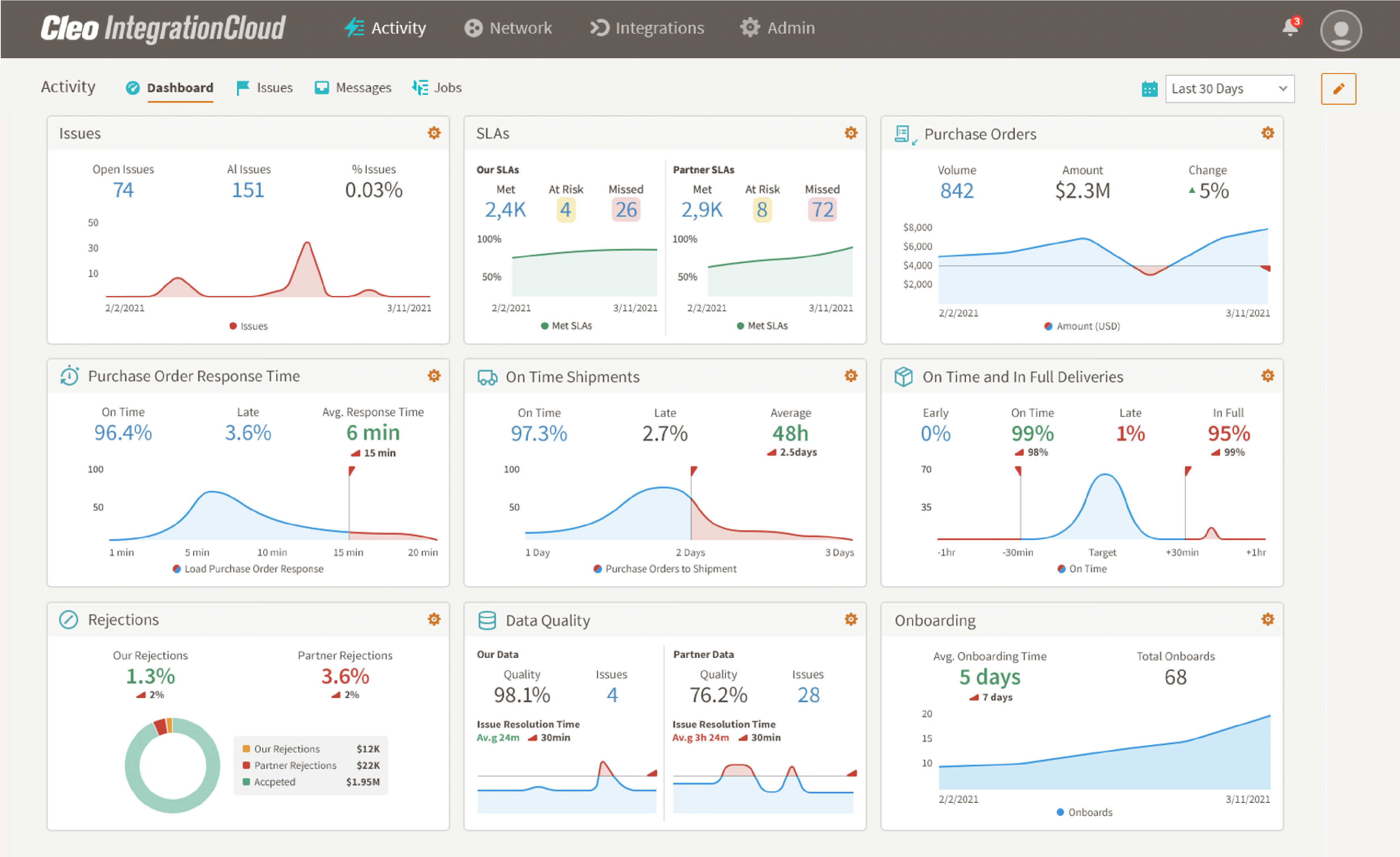
Remember... Relationships matter. And clarity in communication helps them prosper.

About Cleo

Watch a Demo

Comprehensive Guide to Gaining B2B Control

Duraflame Case Study
